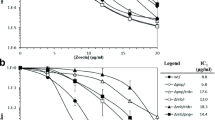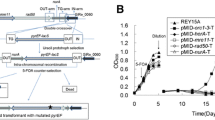Abstract
In Saccharomyces cerevisiae, HOT1-stimulated recombination has been implicated in maintaining homology between repeated ribosomal RNA genes. The ability of HOT1 to stimulate genetic exchange requires RNA polymerase I transcription across the recombining sequences. The trans-acting nuclear mutation hrm3-1 specifically reduces HOT1-dependent recombination and prevents cell growth at 37°. The HRM3 gene is identical to DEG1. Excisive, but not gene replacement, recombination is reduced in HOT1-adjacent sequences in deg1Δ mutants. Excisive recombination within the genomic rDNA repeats is also decreased. The hypo-recombination and temperature-sensitive phenotypes of deg1Δ mutants are recessive. Deletion of DEG1 did not affect the rate of transcription from HOT1 or rDNA suggesting that while transcription is necessary it is not sufficient for HOT1 activity. Pseudouridine synthase 3 (Pus3p), the DEG1 gene product, modifies the anticodon arm of transfer RNA at positions 38 and 39 by catalyzing the conversion of uridine to pseudouridine. Cells deficient in pseudouridine synthases encoded by PUS1, PUS2 or PUS4 displayed no recombination defects, indicating that Pus3p plays a specific role in HOT1 activity. Pus3p is unique in its ability to modulate frameshifting and readthrough events during translation, and this aspect of its activity may be responsible for HOT1 recombination phenotypes observed in deg1 mutants.


Similar content being viewed by others
References
Aguilera A, Klein HL (1988) Genetic control of intrachromosomal recombination in Saccharomyces cerevisiae. I. Isolation and genetic characterization of hyper-recombination mutations. Genetics 119:779–790
Amstutz H, Munz P, Heyer WD, Leupoid U, Kohli J (1985) Concerted evolution of tRNA genes: intergenic conversion among three unlinked serine tRNA genes in S. pombe. Cell 40:879–886
Asakura T, Sasaki T, Nagano F, Satoh A, Obaishi H, Nishioka H, Imomura H, Hotta K, Tanaka K, Nakanishi H, Takai Y (1998) Isolation and characterization of a novel actin filament-binding protein from Saccharomyces cerevisiae. Oncogene 16:121–130
Barnes WM (1978) DNA sequence from the histidine operon control region: seven histidine codons in a row. Proc Natl Acad Sci USA 75:4281–4285
Bayev AA, Georgiev OI, Hadjiolov AA, Kermekchiev MB, Nikolaev N, Skryabin KG, Zakharyev VM (1980) The structure of the yeast ribosomal RNA genes. 2. The nucleotide sequence of the initiation site for ribosomal RNA transcription. Nucleic Acids Res 8:4919–4926
Becker HF, Motorin Y, Planta RJ, Grosjean H (1997) The yeast gene YNL292w encodes a pseudouridine synthase (Pus4) catalyzing the formation of psi55 in both mitochondrial and cytoplasmic tRNAs. Nucleic Acids Res 25:4493–4499
Björk GR (1995) Biosynthesis and function of modified nucleosides in tRNA. In: Söll D, RajBhandary UL (eds) tRNA: structure, biosynthesis, and function. ASM Press, Washington, pp 165–205
Brambilla A, Mainieri D, Carbone MLA (1997) A simple signal element mediates transcription termination and mRNA 3′ end formation in the DEG1 gene of Saccharomyces cerevisiae. Mol Gen Genet 254:681–688
Carbone MLA, Solinas M, Sora S, Panzeri L (1991) A gene linked to CEN6 is important for growth of Saccharomyces cerevisiae. Curr Genet 19:1–8
Charette M, Gray MW (2000) Pseudouridine in RNA: what, where, how, and why. IUBMB Life 49:341–351
Defossez PA, Prusty R, Kaeberlein M, Lin SJ, Ferrigno P, Silver PA, Keil RL, Guarente L (1999) Elimination of replication block protein Fob1 extends the life span of yeast mother cells. Mol Cell 3:447–455
Elion EA, Warner JR (1984) The major promoter element of rRNA transcription in yeast lies 2 kb upstream. Cell 39:663–673
Elion EA, Warner JR (1986) An RNA polymerase I enhancer in Saccharomyces cerevisiae. Mol Cell Biol 6:2089–2097
Fiers W, Contreras RR, Haegemann G, Rogiers R, Van de Voorde A, Van Heuverswyn H, Van Herreweghe J, Volckaert G, Ysbaert M (1978) Complete nucleotide sequence of SV40 DNA. Nature 273:113–120
Freedman JA, Jinks-Robertson S (2002) Genetic requirements for spontaneous and transcription-stimulated mitotic recombination in Saccharomyces cerevisiae. Genetics 162:15–27
Gesteland RF, Weiss RB, Atkins JF (1992) Recoding: reprogrammed genetic decoding. Science 257:1640–1641
Gietz RD, Sugino A (1988) New yeast—Escherichia coli shuttle vectors constructed with in vitro mutagenized yeast genes lacking six-base pair restriction sites. Gene 74:527–534
Guldener U, Heck S, Fielder T, Beinhauer J, Hegemann JH (1996) A new efficient gene disruption cassette for repeated use in budding yeast. Nucleic Acids Res 24:2519–2524
Guyer MS (1983) Uses of the transposon γδ in the analysis of cloned genes. Methods Enzymol 101:362–369
Haber JE, Thorburn PC (1984) Healing of broken linear dicentric chromosomes in yeast. Genetics 106:207–226
Hellmuth K, Grosjean H, Motorin Y, Deinert K, Hurt E, Simos G (2000) Cloning and characterization of the Schizosaccharomyces pombe tRNA: pseudouridine synthase Pus1p. Nucleic Acids Res 28:4604–4610
Huang GS, Keil RL (1995) Requirements for activity of the yeast mitotic recombination hotspot HOT1: RNA polymerase I and multiple cis-acting sequences. Genetics 141:845–855
Keil RL, McWilliams AD (1993) A gene with specific and global effects on recombination of sequences from tandemly repeated genes in Saccharomyces cerevisiae. Genetics 135:711–718
Keil RL, Roeder GS (1984) Cis-acting, recombination-stimulating activity in a fragment of the ribosomal DNA of S. cerevisiae. Cell 39:377–386
Klemenz R, Geiduschek EP (1980) The 5′ terminus of the precursor ribosomal RNA of Saccharomyces cerevisiae. Nucleic Acids Res 8:2679–2689
Koonin EV (1996) Pseudouridine synthases: four families of enzymes containing a putative uridine-binding motif also conserved in dUTPases and dCTP deaminases. Nucleic Acids Res 24:2411–2415
Kramer KM, Brock JA, Bloom K, Moore JK, Haber JE (1994) Two different types of double-strand breaks in Saccharomyces cerevisiae are repaired by similar RAD52-independent, nonhomologous recombination events. Mol Cell Biol 14:1293–1301
Lecointe F, Simos G, Sauer A, Hurt EC, Motorin Y, Grosjean H (1998) Characterization of yeast protein Deg1 as pseudouridine synthase (Pus3) catalyzing the formation of psi38 and psi39 in tRNA anticodon loop. J Biol Chem 273:1316–1323
Lecointe F, Namy O, Hatin I, Simos G, Rousset JP, Grosjean H (2002) Lack of pseudouridine 38/39 in the anticodon arm of yeast cytoplasmic tRNA decreases in vivo recoding efficiency. J Biol Chem 277:30445–30453
Lin Y-H, Keil RL (1991) Mutations affecting RNA polymerase I-stimulated exchange and rDNA recombination in yeast. Genetics 127:31–38
Mann C, Davis RW (1983) Instability of dicentric plasmids in yeast. Proc Natl Acad Sci USA 80:228–232
Morris DK, Lundblad V (1997) Programmed translational frameshifting in a gene required for yeast telomere replication. Curr Biol 7:969–976
Motorin Y, Keith G, Simon C, Foiret D, Simos G, Hurt E, Grosjean H (1998) The yeast tRNA: pseudouridine synthase Pus1p displays a multisite substrate specificity. RNA 4:856–869
Namy O, Duchateau-Nguyen G, Rousset JP (2002) Translational readthrough of the PDE2 stop codon modulates cAMP levels in Saccharomyces cerevisiae. Mol Microbiol 43:641–652
Ouspenski S II, Elledge SJ, Brinkley BR (1999) New yeast genes important for chromosome integrity and segregation identified by dosage effects on genome stability. Nucleic Acids Res 27:3001–3008
Pâques F, Haber JE (1999) Multiple pathways of recombination induced by double-strand breaks in Saccharomyces cerevisiae. Microbiol Mol Biol Rev 63:349–404
Prusty R, Keil RL (2004) SCH9, a putative protein kinase from Saccharomyces cerevisiae, affects HOT1-stimulated recombination. Mol Gen Genomics 272:264–274
Raychaudhuri S, Niu L, Conrad J, Lane BG, Ofengand J (1999) Functional effect of deletion and mutation of the Escherichia coli ribosomal RNA and tRNA pseudouridine synthase RluA. J Biol Chem 274:18880–18886
Roeder GS, Keil RL, Voelkel-Meiman KA (1986) A recombination-stimulating sequence in the ribosomal RNA gene cluster of yeast. In: Klar A, Strathern JN (eds) Mechanisms of yeast recombination. Cold Spring Harbor Laboratory Press, Cold Spring Harbor, pp 29–33
Rong L, Palladino F, Aguilera A, Klein H (1991) The hyper-gene conversion hrp5-1 mutation of Saccharomyces cerevisiae is an allele of the SRS2/RADH gene. Genetics 127:75–85
Rose MD, Novick P, Thomas JH, Botstein D, Fink GR (1987) A Saccharomyces cerevisiae genomic plasmid bank based on a centromere-containing shuttle vector. Gene 60:237–243
Rose MD, Winston F, Hieter P (1990) Methods in Yeast genetics: a laboratory course manual. Cold Spring Harbor Laboratory Press, Cold Spring Harbor
Ruggero D, Grisendi S, Piazza F, Rego E, Mari F, Rao PH, Cordon-Cardo C, Pandolfi PP (2003) Dyskeratosis congenita and cancer in mice deficient in ribosomal RNA modification. Science 299:259–262
Sambrook J, Fritsch EF, Maniatis T (1989) Molecular cloning: a laboratory manual, 2nd edn. Cold Spring Harbor Laboratory Press, Cold Spring Harbor
Sanger F, Nicklen S, Coulson AR (1977) DNA sequencing with chain terminating inhibitors. Proc Natl Acad Sci USA 74:5463–5467
Schwindinger WF, Warner JR (1987) Transcriptional elements of the yeast ribosomal protein gene CYH2. J Biol Chem 262:5690–5695
Simos G, Tekotte H, Grosjean H, Segref A, Sharma K, Tollervey D, Hurt EC (1996) Nuclear pore proteins are involved in the biogenesis of functional tRNA. EMBO J 15:2270–2284
Stewart SE, Roeder GS (1989) Transcription by RNA polymerase I stimulates mitotic recombination in Saccharomyces cerevisiae. Mol Cell Biol 9:3464–3472
Sung P, Trujillo KM, Van Komen S (2000) Recombination factors of Saccharomyces cerevisiae. Mutat Res 451:257–275
Thompson DL, Kalderon D, Smith AE, Tevethia MJ (1990) Dissociation of Rb-binding and anchorage-independent growth from immortalization and tumorigenicity using SV40 mutants producing N-terminally truncated large T antigens. Virology 178:15–34
Voelkel-Meiman K, Roeder GS (1990) A chromosome containing HOT1 preferentially receives information during mitotic interchromosomal gene conversion. Genetics 124:561–572
Voelkel-Meiman K, Keil RL, Roeder GS (1987) Recombination-stimulating sequences in yeast ribosomal DNA correspond to sequences regulating transcription by RNA polymerase I. Cell 48:1071–1079
Wai H, Johzuka K, Vu L, Eliason K, Kobayashi T, Horiuchi T, Nomura M (2001) Yeast RNA polymerase I enhancer is dispensable for transcription of the chromosomal rRNA gene and cell growth, and its apparent transcription enhancement from ectopic promoters requires Fob1 protein. Mol Cell Biol 21:5541–5553
Wolfe KH, Lohan AJ (1994) Sequence around the centromere of Saccharomyces cerevisiae chromosome II: similarity of CEN2 to CEN4. Yeast 10:S41–S46
Yarian C, Townsend H, Czestkowski W, Sochacka E, Malkiewicz AJ, Guenther R, Miskiewicz A, Agris PF (2002) Accurate translation of the genetic code depends on tRNA modified nucleotides. J Biol Chem 277:16391–16395
Yuan LW, Keil RL (1990) Distance-independence of mitotic intrachromosomal recombination in Saccharomyces cerevisiae. Genetics 124:263–273
Acknowledgements
We thank Susan DiBartolomeis, Tom Reiner, Laura Palmer and Reeta Prusty for sharing their valuable technical expertise, and Anita Hopper for critical reading of the manuscript. Technical assistance from Jonathan Morgan and Paul Lewis is also appreciated. Plasmids containing deg1-D151A and controls were kindly provided by Henri Grosjean (CNRS, Laboratoire d‘Enzymologie et de Biochimie Structurales, France). This research was supported by funding from the Pennsylvania State System of Higher Education Faculty Professional Development Council and the Millersville University Faculty Grants Committee to CEH, a Sigma Xi Grant-in-Aid of Research to KGS, Millersville University Alumni Association Neimeyer-Hodgson Student Research Grants to MM, AR, GIL and DLH, and by National Institutes of Health grant GM-36422 to RLK.
Author information
Authors and Affiliations
Corresponding author
Additional information
Communicated by A. Aguilera
Rights and permissions
About this article
Cite this article
Hepfer, C.E., Arnold-Croop, S., Fogell, H. et al. DEG1, encoding the tRNA:pseudouridine synthase Pus3p, impacts HOT1-stimulated recombination in Saccharomyces cerevisiae . Mol Genet Genomics 274, 528–538 (2005). https://doi.org/10.1007/s00438-005-0042-3
Received:
Accepted:
Published:
Issue Date:
DOI: https://doi.org/10.1007/s00438-005-0042-3




